
100,000 ... not the number of visitors to this show, but the number of flowers at the garden centre where it’s held! If your partner is more interested in plants than old cars, this could be the perfect afternoon out. Laurent Laplace has created a unique event to celebrate the ‘Fête du muguet’ (the lily of the valley) every spring. Held in Chelles, in the eastern suburbs of Paris, it’s close to Disneyland and the A4 autoroute.
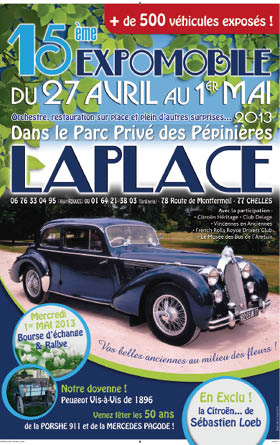
The Laplace family has run this show for over 15 years. (Courtesy Jardinerie Laurent Laplace)
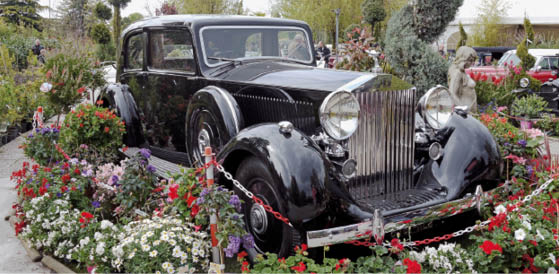
The French Rolls-Royce Drivers’ Club is one of those supporting this event.
Among the colourful displays of roses, geraniums and petunias, the show presents a varied mix of classic cars, from pre-1900 veterans to recent supercars. The event is well supported by owners’ clubs, such as Les Amis de Delage or Vincennes en anciennes, and even, in 2013, by Citroën Heritage, which sent along Sébastien Loeb’s rally-winning Xsara WRC.
Chelles is home to the AMTUIR bus museum, which is generally closed to the public, but usually displays a couple of old Paris buses at this show, which is an added bonus. There is a large grassy area behind the garden centre, too, so that collectors can bring their own cars and sit down to enjoy some live music or a refreshing drink.

An early Chevrolet Corvette among the flowers.
Practical Information
- Opening Information: Around May 1 holiday every year
- Address: Jardinerie Laplace, 78, route de Montfermeil, 77500 Chelles
- Train Services: RER line E to Chelles Gournay, then bus 613, stop rue Prudence
- GPS Coordinates: 48.889503 N, 2.582506 E
- Website: www.jardinerie-laplace.fr
- Telephone Number: +33 (0)1 64 21 38 03
- Email: laurent.laplace77@orange.fr


Exposition Concept Cars, Paris
This show is little known outside France, but is a rare treat for visitors to the capital. It’s a highlight of the week-long International Automobile Festival, which takes place shortly before Rétromobile, and celebrates contemporary car design.
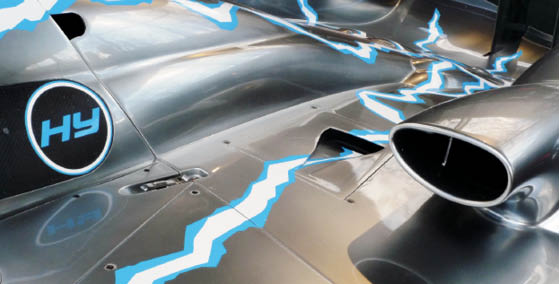
Peugeot 908 HY.

BMW 328 Hommage.
The Concept Car Show is held in a large marquee (with 40% more space added in 2014) in front of the Invalides, where Napoléon is buried. Visiting it at nightfall, when the golden dome is floodlit, is an especially magic moment. The show is a unique opportunity for the public to see a wide range of design studies from studios across Europe. Many of the cars are the stuff of dreams, like the Touring Disco Volante, the Peugeot Onyx – with its audacious copper panels – or the latest concepts from Giugiaro’s Italdesign. Others – like the Renault Alpine A110-50 or BMW 328 Hommage – hark back to their manufacturer’s heritage. But the show also gives a glimpse of the design direction of mainstream cars closer to production: Mini’s Paceman, Renault’s Initiale Paris and Citroën’s ‘Wild Rubis’ concepts have all been shown here. As well as more than 20 concept cars, recent shows have featured motorbikes and displays of motoring art and sculptures.

Citroën C-Cactus concept in front of the Invalides.
Practical Information
- Opening Information: End of January/early February each year
- Address: In front of the Invalides dome, place Vauban, 75007 Paris
- Metro Line: Line 13, Varenne
- Bus Services: Lines 82 & 92
- GPS Coordinates: 48.853881 N, 2.31237 E
- Website: www.festivalautomobile.com
- Telephone Number: +33 (0)1 40 74 96 00
- Email: desk@festivalautomobile.com


Locomotion en fête, La Ferté-Alais
Of all the events described in this region, Locomotion en fête is one of the best for the whole family to enjoy. Old cars are just part of the show, which is a celebration of all things mechanical and attracts enthusiasts from across Europe. The extensive showgrounds around the aerodrome at Cerny are divided into areas for cars, lorries, traction engines and more. If you have ever been to the Great Dorset Steam Fair in the UK, you’ll probably enjoy the relaxed atmosphere of this event. Some of the vehicles on display, like a 1920s Aveling & Porter steamroller, built in Kent, may be familiar; others, like the impressive line-up of French Bernard trucks, may be new discoveries.

Demonstration area for World War Two tanks.

Rides for all the family. (Courtesy Bertrand Viet)
A key to this show’s appeal is the number of live events that take place: whether it’s looking at a demonstration of 19th century farm machinery, enjoying a ride around the showgrounds behind a traction engine, or watching a flypast of early biplanes, there’s always something different to do. Best of all are the great demonstrations of tanks and other military vehicles, some of them from major collections such as the Musée des Blindés at Saumur, re-enacting battle scenes from the Second World War.

Part of a special display of Bernard lorries.
Practical Information
- Opening Information: May/June every year
- Address: Aérodrome de Cerny, 91590 La Ferté-Alais
- Train Services: RER line D to La Ferté-Alais, then free shuttle
- GPS Coordinates: 48.495351 N, 2.348104 E
- Website: www.locomotion-en-fete.com
- Telephone Number: +33 (0)6 03 18 07 25
- Email: acpht@aliceadsl.fr


Rallyes de Paris GT et Classic
If you imagine what an ideal classic rally in France might be, you’ll probably think of driving along open roads in the French countryside, stopping at a château or two and enjoying some fine meals and great wine. Add to that mix a couple of sessions on famous racetracks and you have the formula for the Rallye de Paris.

The Rallye de Paris GT in front of the château at Chambord. (Courtesy Rallystory/Philippe Fugier)

The Eiffel Tower, traditional starting point for the Rallye de Paris. (Courtesy Rallystory/ Philippe Fugier)
Created by Hervé Charbonneaux for Parisian enthusiasts more than 20 years ago, the Rallye de Paris has grown into one of the best organised and most stylish events of its kind, attracting participants from all over Europe. The Rallye Classic, for cars up to 1986, is now run in parallel with the Rallye GT, for modern GT and supercars. Held over two-and-a-half days, it’s shorter and less expensive to take part in than the Tour Auto.
This is not a regularity event, so the road stages follow a set route, but with no time constraints. Starting from Paris, in recent years participants have driven through Burgundy and the Sologne, savouring meals at the châteaux of Fontainebleau, Meursault and Pommard. Each day also includes a session at one of France’s major circuits, such as Dijon-Prenois or Magny-Cours.
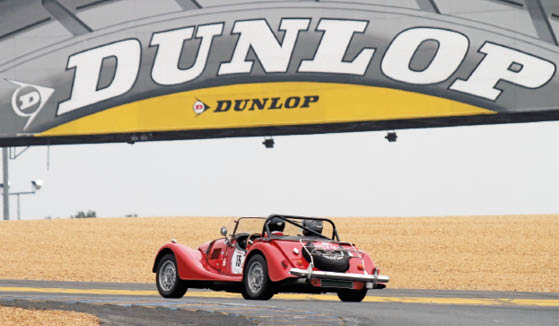
On the track at Le Mans with the Rallye de Paris Classic. (Courtesy Rallystory/Car Media)
Practical Information
- Opening Information: March every year
- Address: Starts from Trocadéro fountains opposite Eiffel Tower, 75116 Paris
- Metro Line: Lines 6 & 9, Trocadéro
- Bus Services: Lines 72 & 82
- GPS Coordinates: 48.861612 N, 2.289285 E
- Website: www.rallystory.com
- Telephone Number: +33 (0)1 42 12 07 08
- Email: contact@rallystory.com


The story of the Rallye des Princesses really begins back in 1929, when the Comte de Rohan-Chabot launched a motoring event exclusively for women, the Rallye Paris-Saint Raphaël, which ran until 1974. 26 years later, Viviane Zaniroli created a new rally in the same spirit, the Rallye des Princesses. Nearly 90 all-women crews, with their cars divided into Historic, Classic and Prestige classes, set off each year from Paris to drive to the south of France, finishing five days later in a resort such as Saint-Tropez.
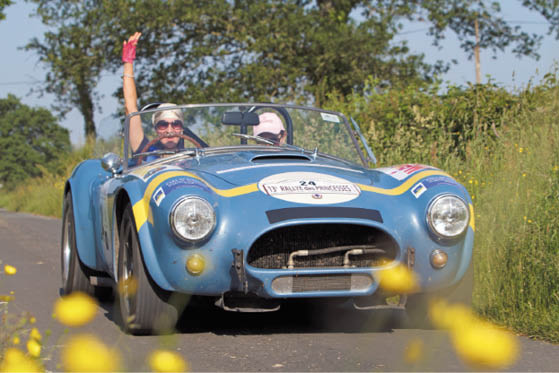
The joy of the open road. (Courtesy Richard Bord/Zaniroli Classic Events)
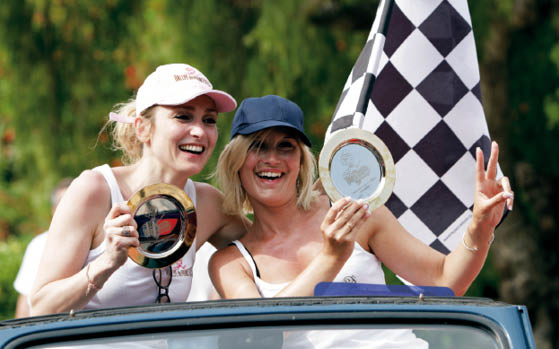
Victory! (Courtesy Richard Bord/Zaniroli Classic Events)
For some of the competitors it’s a serious sporting challenge, while others see it more as a chance to get away from it all. For these drivers and their navigators, the pace of the rally can come as a shock: entrants cover 300km (180 miles) or more each day, often on minor roads. The rally is run on strict regularity principles, and the crews are required to match an average speed of between 40-50kph (25-31mph), according to the age of their car. But the rally’s motto is ‘Sportswoman by day, Princess by night,’ and each day ends in some style, with an especially lavish gala dinner on the last day.

Flagging the starters from the Invalides in Paris. (Courtesy Richard Bord/Zaniroli Classic Events)
Practical Information
- Opening Information: June every year
- Address: Starts from Esplanade des Invalides, 75007 Paris
- Metro Line: Line C (RER) or lines 8 & 13, Invalides
- Bus Services: Lines 69 & 93
- GPS Coordinates: 48.858577N, 2.314326 E
- Website: www.zaniroli.com/rallye-des-princesses
- Telephone Number: +33 (0)4 92 82 20 00
- Email: info@zaniroli.com
